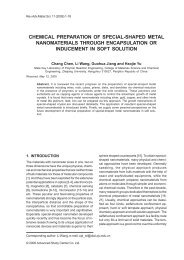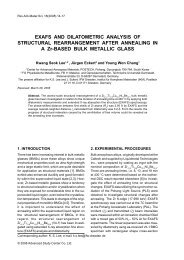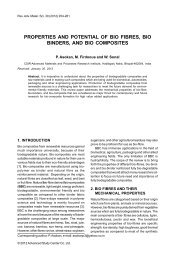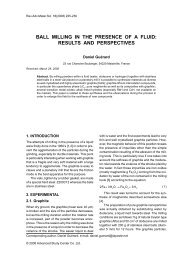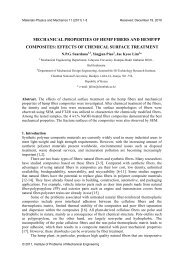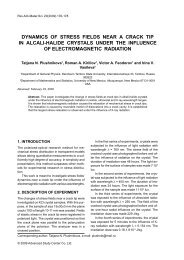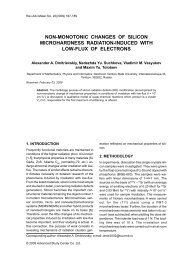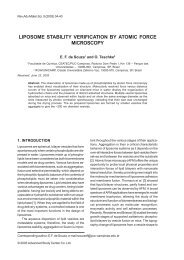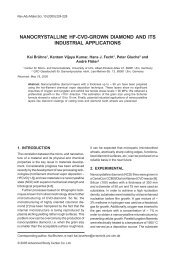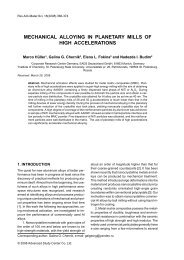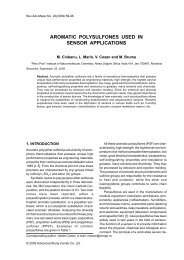surface pretreatment by phosphate conversion coatings – a review
surface pretreatment by phosphate conversion coatings – a review
surface pretreatment by phosphate conversion coatings – a review
Create successful ePaper yourself
Turn your PDF publications into a flip-book with our unique Google optimized e-Paper software.
164 T.S.N. Sankara Narayanan<br />
Fig. 17. Anodic polarization curve obtained for zinc <strong>phosphate</strong> coated steel in 0.6 M ammonium nitrate.<br />
related to the porosity of the <strong>phosphate</strong> coating.<br />
Kiss and Coll-Palagos [355] termed this peak as<br />
‘porosity peak’. The peak height at <strong>–</strong>800 mV or the<br />
integrated area under this anodic peak was used to<br />
predict the porosity.<br />
Anodic polarization study in 0.6 M ammonium<br />
nitrate solution is one of the recommended methods<br />
of electrochemical evaluation of corrosion resistance<br />
of <strong>phosphate</strong> <strong>coatings</strong> (Fig. 17) [346]. During<br />
anodic polarization in 0.6 M ammonium nitrate<br />
solution, at potentials more negative than <strong>–</strong>0.33 V,<br />
<strong>phosphate</strong>d steel undergoes active dissolution.<br />
Above <strong>–</strong>0.33 V, the first passivation region occurs<br />
due to the adsorption of hydroxide ions at the electrode<br />
<strong>surface</strong>. The occurrence of the second active<br />
region is due to the replacement of hydroxide ions<br />
<strong>by</strong> <strong>phosphate</strong> ions available at the electrode/solution<br />
interface. Replacement of the adsorbed <strong>phosphate</strong><br />
ions <strong>by</strong> nitrate causes the occurrence of the<br />
second passive region. Hence it is clear that these<br />
active and passive regions are the result of the competitive<br />
and potential dependent adsorption of anions<br />
at the electrode <strong>surface</strong>. It should be noted<br />
here that the appearance of this second current<br />
density maximum is specific to <strong>phosphate</strong>d steel<br />
and it is not observed for uncoated steel when tested<br />
under similar conditions. Hence the value of the<br />
second current density maximum can be used to<br />
evaluate the corrosion resistance of different <strong>phosphate</strong><br />
<strong>coatings</strong> [346].<br />
The other important method of evaluation of the<br />
corrosion resistance of <strong>phosphate</strong> <strong>coatings</strong> is the<br />
electrochemical impedance spectroscopy (EIS). It<br />
provides a rapid, nondestructive means of evaluating<br />
corrosion rate and mechanism of corrosion of<br />
<strong>phosphate</strong> <strong>coatings</strong>. Literature reports on the evaluation<br />
<strong>phosphate</strong> <strong>coatings</strong> [357-363] suggest that the<br />
corrosion behaviour of <strong>phosphate</strong> <strong>coatings</strong> in contact<br />
with the corrosive medium (3.5% NaCl) can be<br />
explained on the basis of a porous film model since<br />
the electrolyte/coating-metal interface approximates<br />
such a model. Accordingly, the <strong>phosphate</strong>d substrates<br />
are considered as partially blocked electrodes<br />
when comes in contact with 3.5% NaCl solution.<br />
This implies that the metal substrate is corroding<br />
in the same way when unprotected in a much<br />
smaller area where coverage is lacking. Since the<br />
capacitive and resistive contributions vary directly<br />
and indirectly, respectively, with respect to the area,<br />
based on these measured parameters, predictions<br />
on the corrosion rate of different <strong>phosphate</strong> <strong>coatings</strong><br />
can be easily made. Fig. 18 shows the Nyquist<br />
plot obtained for zinc <strong>phosphate</strong> coated steel in 3.5%<br />
NaCl solution exhibiting a semicircle in the high fre-



